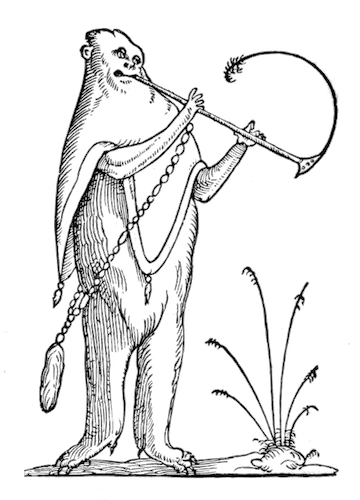
Oskar Kokoschka, Hermine Moos, and the Alma Mahler Doll
When Oskar Kokoschka fell in love with Alma Mahler, he fell harder than Satan into Hell. “What you are, I am: if you turn from me, I am once again like no one and have no world”, he wrote on April 26, 1912. “I live in you, and I only live truly and really for as long as you believe in me.” They had met, by some accounts, while the thirty-two-year-old composer was still wearing a mourning veil; her husband, Gustav Mahler, had died the previous spring. Oskar had been asked to paint Alma’s portrait by her stepfather, but the Viennese artist didn’t make the best of first impressions. He was twenty-six, appeared impoverished, and kept coughing up blood. “He hardly spoke, and yet seemed unable to draw. We stood up—and suddenly he embraced me passionately. But this kind of embrace was strange and alien. I did not respond at all—and exactly that seemed to affect him. He stormed out.”
But he won her over with words, delivering “the most beautiful love letter” a few days later. Some four hundred more would follow. “The three years with him were a hefty love-battle. Never before have I tasted so many spasms, so much hell and so much paradise”, Alma would recall. Oskar’s jealousy was immeasurable. Early in their relationship, he would pass the night pacing before her window while whistling, supposedly guarding against clandestine lovers but actually keeping her awake till dawn. Even the dead did not escape his envy. “Because I am superstitious”, he would admit in his autobiography, “I had always insisted that nothing of the dead Gustav Mahler, not even his bust of Rodin, should be brought into our house.” His art became a place to express his fears and passion: he drew her having sex with other men; he drew her spinning yarn with his own intestines. Family and friends witnessed the amour fou’s effect upon the couple. “If you see Oskar again, I’ll shoot you”, his mother, Romana — who referred to Alma as “Circe” — once threatened.
Visiting her sister in Baden Baden in September, 1912, Alma confirmed what she had suspected since late July: she was pregnant. She quickly returned to Vienna, to an empty flat, only to be confronted by the face of her dead husband, whose death mask had been installed in their living room without her consent — the latest paroxysm of Oskar’s obsession. “I suddenly felt: I am not Oskar’s wife!” She had an abortion in mid-October; he insisted on pocketing a bloodied cotton pad from the operation: “This is my only child and always will be.” Several years of agony followed, peppered with inconsistent pleasures. Alma eventually resumed an intimate correspondence with Bauhaus founder Walter Gropius; Oskar enlisted in the Austrian cavalry in 1914 at the outbreak of World War I.
In 1918, after years of war — and after recovering from a bayonet wound in Vienna and shellshock in Dresden — Oskar was still thinking of Alma. She had married Gropius in 1915, but the veteran’s need to possess her did not abate. And so he did what few would (hopefully) ever think to do: he wrote to the puppet maker Hermine Moos in Munich, who was rumored to have once served as Alma’s seamstress, and inquired about the possibility of recreating his lover as a life-size doll. “Should you be successful, dear Miss Moos, in projecting such a feat of legerdemain that the woman of my dreams will seem to come alive to my eyes and touch, I shall be deeply indebted to your inventiveness and feminine sensibility.”
Hermine Moos with the papier-mâché skeleton of the Alma Mahler doll, ca. 1919 — Source
Hermine Moos with the Alma Mahler doll in her Munich apartment, ca. 1919 — Source.
Moos was his second choice: the well-regarded designer Lotte Pritzel had declined the project after seeing Oskar’s sketches. His instructions were obsessively detailed, his goals rather transparent. “Please make it possible that my sense of touch will be able to take pleasure in those parts where the layers of fat and muscle suddenly give way to a sinuous covering of skin.” He wrote Moos a dozen letters, sent her a life-size painting of Alma, and asked to sample textiles and prototypes of limbs. He fixated on the doll’s intimate bits, which were meant to be made from “fine, curly horsehair”, reclaimed from a disinfected sofa, and “pouches stuffed with down, cottonwool for the seat and breasts”. Oskar was at least partially aware of the repugnancy of his ask. “Although I feel ashamed I must still write this, but it remains our secret (and you are my confidante): the parties honteuses must be made perfect and luxuriant and covered with hair, otherwise it is not to be a woman but a monster.” Despite swearing Moos to secrecy, he likely had an eye toward posterity while penning these letters: they were published six years later in a volume titled Der Fetische. Moos’ responses have not survived.
The Alma Mahler doll in Hermine Moos’ apartment, ca. 1919 — Source
The Alma Mahler doll as Venus in Hermine Moos’ apartment, 1919 — Source
The recipient of these letters acted more like Frankenstein than Pygmalion. Her doll came to better resemble the grotesque desires of its commissioner — whom the Viennese press once declared “the wildest beast of all” — than the idealized features of its referent. Oskar’s butler is said to have suffered a stroke upon first seeing the creature, for Moos had fleshed it with swan skin, complete with feathers, which was sewn onto sawdust bags. Oskar, who had requested “peach-like”, gossamer skin, felt that he had purchased a taxidermied bear.
I was prepared to make allowances to subtract from my fancy in favour of reality; but in too many ways she belies what I demanded of her and expected of you. The outer shell is a polar-bear pelt, suitable for a shaggy imitation bedside rug rather than the soft and pliable skin of a woman. . . . The knees seem to be afflicted with elephantitis. . . . The result is that I cannot even dress the doll, which you knew was my intention, let alone array her in delicate and precious robes. Even attempting to pull on one stocking would be like asking a French dancing-master to waltz with a polar bear.
Some read Moos’ failure as a defiant act of artistic intervention, the feathers an allusion to Leda’s rape by Zeus in bird form. (Oskar had instructed the dollmaker to touch herself, rather than consult anatomical diagrams, if she was uncertain about specific physiological details.) Others suspect that the wartime rationing of linen and silk was to blame for this roughly textured Galatea.
Oskar learned to love — or at least live with — the monster, hiring a maid named Hulda (whom he insisted on calling Russerl) to wait on it hand and webbed foot. He hard launched their relationship at prominent cafes, operas, and parties thrown in its honor. He represented the doll incessantly, as he had once captured Alma’s attitudes, creating pen-and-ink drawings and oil paintings. Woman in Blue (1919), Self-Portrait with Doll (ca. 1920–21), and At the Easel (1922) all hail from this period. In his old age, he remembered the doll differently, replacing the initial disappointment he had expressed in letters to Moos with a glowing, almost beatific autobiographical account. “In a state of feverish anticipation, like Orpheus calling Eurydice back from the Underworld, I freed the effigy of Alma Mahler from its packing. As I lifted it into the light of the day, the image of her I had preserved in my memory stirred into life. The light I saw at that moment was without precedent.”
Oskar Kokoschka, Self-Portrait with Doll, ca. 1920–21 — Source
Oskar Kokoschka, Woman in Blue, 1919 — Source
But this was fifty years after the doll’s symbolic execution, when, one morning in the early 1920s, a neighbor called the police upon spotting a headless, bloodied corpse in the garden of the artist’s Dresden home. Oskar had decapitated his ersatz lover and broken a bottle of red wine over its head. “It had managed to cure me completely of my Passion.” Oskar and Alma nevertheless remained in touch, though their last glimpse of each other was in Venice, 1927, where they did not exchange a word. In 1951, he wrote to his former lover with an offer: “If I ever find the time, then I’ll make you a life-size wooden figure of myself, and you should take me to bed with you every night. The figure should also have a member . . . so you can remember me better and through practice also acquire a lust for the real thing again. We will get together again some time.” They did not.
Special thanks to Mathilde Montpetit and Alexander Wells.
Enjoyed this piece? We need your help to keep publishing.
The PDR is a non-profit project kept alive by reader donations – no ads, no paywalls, just the generosity of our community. It’s a really exciting model, but we need your help to keep it thriving. Visit our support page to become a Friend and receive our themed postcard packs. Or give a one-off donation. Already a supporter? A huge thank you for making all this possible.
Apr 22, 2025







-edit.jpg?width=1200&height=850)





